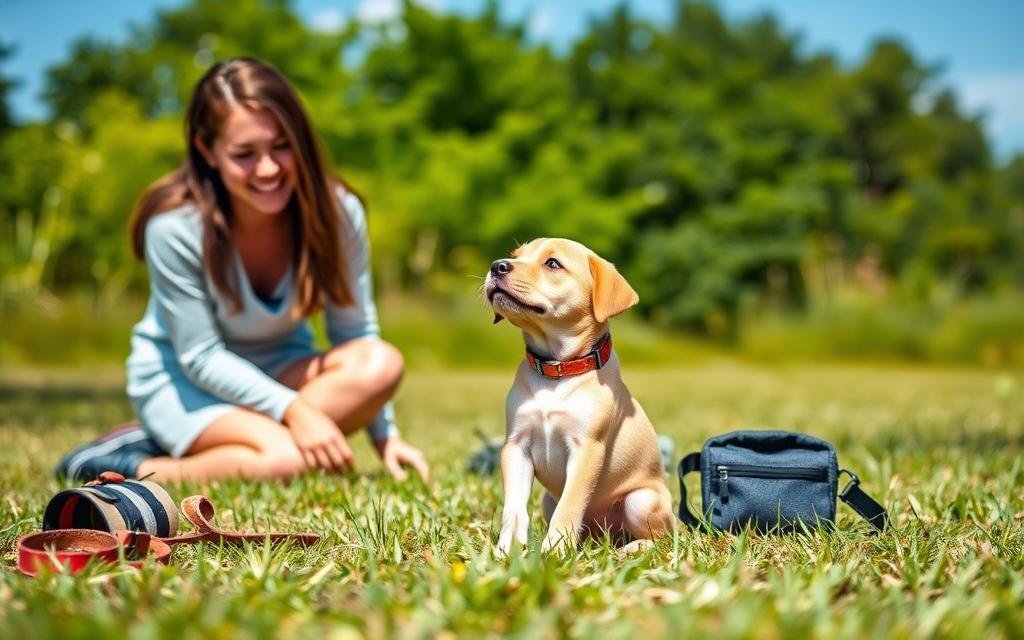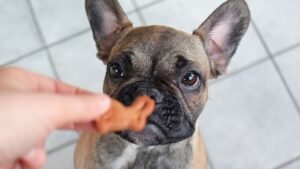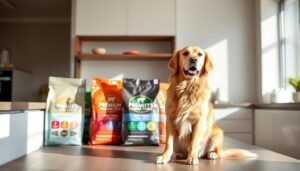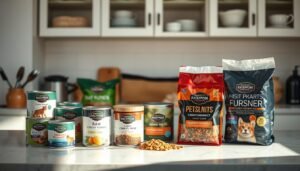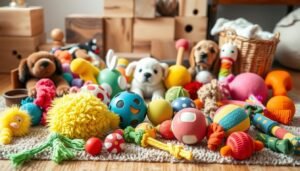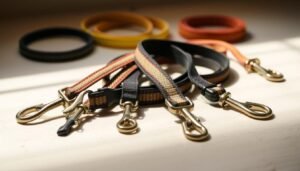Did you know puppies can learn over 165 words and commands by six months old? This shows how important it is for new pet owners to start puppy training early. When I brought my puppy home, I learned quickly that knowing how to train a puppy is key to a well-behaved pet.
From the first day, setting routines, mastering potty training, and using positive reinforcement are vital. These steps help avoid future behavioral problems. Whether it’s crate training or obedience training, every moment teaching your puppy strengthens your bond and promises a lifetime of happiness.
Key Takeaways
- Start puppy training early for best results.
- Establish routine and structure in training sessions.
- Use positive reinforcement to encourage desired behaviors.
- Address issues like puppy potty training promptly.
- Consistency is key to successful puppy obedience training.
Understanding Puppy Behavior
Understanding puppy behavior is key to a strong bond with my new pet. Puppies talk through actions, driven by instinct and curiosity. Knowing why they act certain ways helps me support their growth.
Why Do Puppies Behave This Way?
Puppies are full of energy and curiosity, leading to fun but sometimes chaotic play. They chew and chase to learn and understand their world. Puppy shy behaviors, like hiding, show they might be anxious or new to things. By knowing this, I can steer their energy to good activities instead of scolding.
Common Puppy Behaviors to Watch For
It’s vital to keep an eye on common puppy behaviors. These include:
- Chewing on furniture or shoes
- Jumping on people or furniture
- Barking for attention
- Play biting during interactions
- Exploring their environment excitedly
Knowing these behaviors helps me guide them. It also leads to better training and a happy life together.
The Importance of Early Socialization
Early socialization is key for a puppy’s growth. It helps them become confident and well-adjusted dogs. I make sure my puppy meets different people and animals.
What Socialization Should Include
Socialization for puppies means exposing them to many experiences. Important parts include:
- Meeting different people, including children and seniors
- Interacting with various animals, such as dogs, cats, and farm animals
- Exploring different environments like parks, busy streets, and stores
- Experiencing a range of sounds, like traffic, construction, and everyday household noises
- Encountering diverse textures, including grass, sand, and concrete
Benefits of Early Exposure
Early exposure has many benefits. It helps my puppy grow into a happy, fearless dog. It prevents fearfulness and builds a well-rounded personality. Other benefits include:
- Reducing anxiety in new situations
- Building confidence in social interactions
- Fostering curiosity and exploration
How to Introduce My Puppy to New Experiences
I introduce my puppy to new things slowly. I make sure each experience is positive and fun. Some effective tips include:
- Arranging puppy playdates with friendly, vaccinated dogs
- Visiting pet-friendly stores or parks
- Exposing my puppy to various sights, sounds, and smells in controlled environments
- Rewarding my puppy with treats and praise during new experiences
Basic Commands Every Puppy Should Learn
Teaching basic commands is key to a well-behaved dog. Commands like sit, stay, come, and down are essential. Consistent training helps my puppy interact well with the world.
Teaching Sit and Stay
The sit command is a first step in training puppies. I hold a treat above their nose and move it back. This makes them sit. When they do, I praise them a lot.
For the stay command, I ask them to sit and then step back. Holding my palm out, I reward them if they stay. This teaches them to stay calm.
Teaching Come and Down
The come command is vital for safety. I call their name and say “come” when I have treats. Each time they come, I reward them.
The down command is also important. I move a treat from their nose to the floor. When they lie down, I praise them.
Celebrating Small Successes
Every small success is worth celebrating. I reward them with treats, praise, and affection. This strengthens our bond and encourages good behavior.
Making training fun and rewarding is important. It makes learning enjoyable for both of us.
Creating a Training Schedule
Creating a consistent puppy training schedule is key. It makes learning easier for both me and my puppy. By setting specific times for training, my puppy knows when it’s time to learn.
I aim to train my puppy 2-3 times a day. Each session focuses on different commands. This keeps my puppy excited and focused.
Timeframes for Different Commands
Choosing the right time for each command is important. Simple commands like “sit” or “stay” need short sessions, about 5-10 minutes. For more complex commands, like “come” or “down,” I can extend the time.
This approach prevents my puppy from getting tired. It also keeps training fun and engaging.
How Often to Train Each Day
Training frequency is vital for my puppy’s growth. Training 2-3 times a day gives them enough chances to learn. I also include short play breaks to keep things enjoyable.
Switching between training and play helps. It makes learning less stressful and more effective.
Choosing the Right Training Method
Finding the best training methods for puppies is key to success in pet ownership. Positive reinforcement is a game-changer. It rewards good behavior with treats, praise, or playtime, building a happy and trusting bond. Punishment, on the other hand, can confuse and scare puppies, leading to setbacks.
Positive Reinforcement vs. Punishment
I always choose positive reinforcement over punishment. It builds a strong bond and encourages good behavior. Punishment can damage trust, making puppies anxious and less eager to learn.
Clicker Training Explained
Clicker training is a top choice for me. It uses a small device that makes a clicking sound to mark good behavior. This method is based on positive reinforcement, making it great for shaping behaviors. The click sound is quick and clear, helping puppies connect actions to rewards.
Finding What Works Best for My Puppy
Every puppy is different, so I watch how mine reacts to training methods. I see how they respond to positive reinforcement and clicker training. By trying different techniques, I create a training plan that works best for them, improving our communication and making learning easier.
Establishing House Rules
Setting clear house rules for puppies is key to their growth. By defining these boundaries early, my puppy knows what’s okay. This clarity stops confusion and builds a respectful bond between us.
It’s vital to be consistent. This creates a stable environment that supports these rules.
Defining Boundaries Early
Setting house rules from the start guides my puppy’s behavior. It teaches them what’s okay and what’s not. For example, deciding where they can go in the house makes them feel safe.
Consistency is Key
Being consistent with house rules is essential. If I’m lenient sometimes, my puppy gets mixed signals. Daily consistency helps them understand the rules’ importance.
Creating routines helps my puppy feel secure. It also helps them learn what’s acceptable.
Using Crate Training Effectively
Crate training is a great way to teach discipline. A crate is a safe spot for my puppy, helping with training and giving them a cozy place. I make crate time fun by adding toys and treats.
This makes my puppy see the crate as a safe space. It also makes training easier and reinforces the need for boundaries.
Dealing with Common Behavioral Issues
Starting my journey with a puppy means facing common issues head-on. Early action on behavioral problems can prevent future troubles. Biting and nipping are big challenges, but with the right approach, my puppy can learn better ways to play.
Creating a peaceful home is my goal. Managing excessive barking and potty training will be key to success.
Biting and Nipping Solutions
Puppies use their mouths to explore, leading to nipping. Redirecting them to chew toys is a smart move. This satisfies their chewing urge and teaches them what’s okay to bite.
Consistency is essential. Every nip is a chance to teach them better. Over time, they learn what’s acceptable.
Managing Excessive Barking
Excessive barking can be a problem, showing my puppy wants attention or is anxious. I identify what makes them bark. It might be the mailman or another dog.
Understanding these triggers helps me teach my puppy to behave differently. Commands like “quiet” are very helpful.
Addressing Potty Training Struggles
Potty training is a big challenge. I make sure my puppy goes out often to learn where to go. Positive reinforcement when they do go outside encourages them.
If accidents happen, I clean up calmly without scolding. Remember, every puppy learns at their own pace.
The Role of Patience in Training
Patience is key in puppy training. Each puppy learns at their own pace. By being patient, I can adjust my training to meet their needs.
Understanding My Puppy’s Learning Pace
Knowing how your puppy learns is important. Commands take different times to learn. I watch my puppy’s reactions to adjust my training.
If they seem confused, I simplify my instructions. This helps them understand better.
Staying Calm During Frustrations
Staying calm is vital during training. My puppy picks up on my energy. Being calm sets a positive example and creates a safe learning space.
This helps build trust. My puppy feels secure and is more open to learning.
Finding Professional Help
Dealing with puppy training alone can be tough. If I face ongoing problems or need more help, getting a puppy trainer is key. They offer structured advice and help me feel more confident as a pet owner.
When to Consider a Trainer
I should look into hiring a professional puppy trainer if my puppy has ongoing issues. Problems like too much barking, separation anxiety, or being too hyper need expert help. A trainer can provide personalized solutions, making training more successful.
What to Look for in a Puppy Training Class
Finding the right puppy class is important. Here’s what I look for:
- Positive reinforcement methods: Classes that use positive reinforcement tend to work better and create a supportive environment for my puppy.
- Good reviews: Feedback from other pet owners gives me a glimpse into the training quality and the trainer’s experience.
- Socialization opportunities: A good class should include chances for my puppy to meet other dogs and people.
By focusing on these points, I can find the best professional puppy training class. This will make our training journey positive and effective for my furry friend.
Keeping Training Fun and Engaging
Training my puppy doesn’t have to be boring. It can be fun for both of us. Using puppy training games makes our sessions more exciting. Games like fetch or hide-and-seek make learning fun and keep my puppy’s mind sharp.
Also, celebrating my puppy’s small wins strengthens our bond. When they learn something new, I give them praise or a treat. This keeps them motivated and eager to learn, making our time together both educational and fun.
By mixing play into our training and celebrating their achievements, we create a positive atmosphere. This approach helps us build trust and reinforces good behaviors. It makes every training session a fun adventure, deepening our connection and making my puppy a well-behaved companion.

